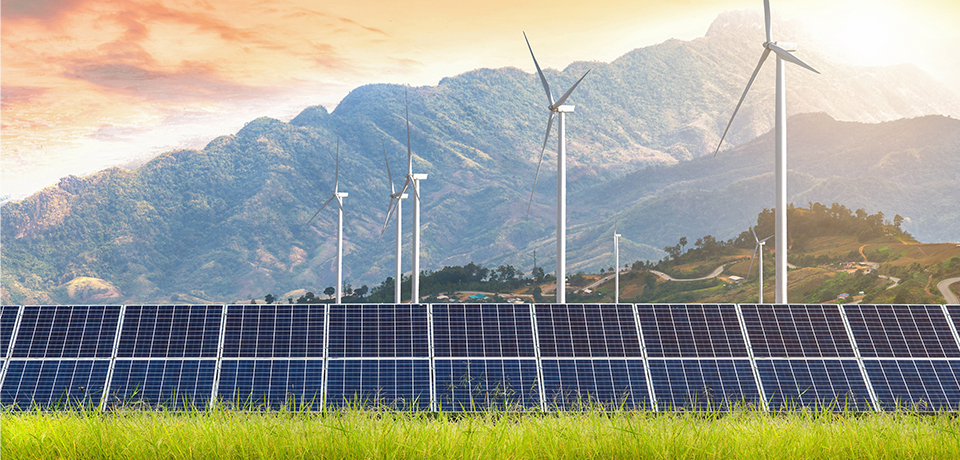4. Renewable Energy Provides Employment
- Home Page
- Blog
- Renewable Energy
- 4. Renewable Energy Provides Employment

Renewable energy (sources) is the energy derived from the flow of continuous natural processes. These resources are listed as sunlight, wind, running water (hydropower), biological processes and geothermal.
In general, renewable energy source is defined as the ability to renew itself at the same rate as the energy taken from the energy source or faster than the depletion rate of the source. For example, a technology that works with the energy obtained from the sun consumes this energy, but the energy consumed is very small compared to the total solar energy. The most common form of renewable energy comes from the sun. Some forms store solar and wind power.
Factors That Generate Renewable Energy
Energy holds place at the crux of the climate problem and is the key for the solution. Most of the greenhouse gases that cover the earth and trap the sun's heat emerge by burning of the fossil fuels to generate electricity and heat energy. Fossil fuels such as petroleum (oil), gas and coal, by accounting for more than 75 percent of global greenhouse gas emissions and about 90 percent of all the carbon dioxide emissions, are listed among the leading factors of global climate change.
According to science, to avoid the adverse effects of the climate change, emissions need to be cut by almost half by 2030 and should reach net zero by 2050. To achieve this, we must end our dependence on fossil fuels and invest in clean, accessible, affordable, sustainable and reliable alternative energy sources. Renewable energy sources, consisting of the sun, wind, water, waste and Earth's heat, are replenished by nature and release little or no greenhouse gases or pollutants into the air.

Accelerating the transition to clean energy is the way to a healthy, livable planet for today and future generations. Because:
1. Renewable Energy Sources are Everywhere.
About 80 percent of the global population lives in net fossil fuel importing countries. This makes nearly 6 billion people from other countries dependent on fossil fuels vulnerable to geopolitical crises. In contrast, existing and potential renewable energy sources are not yet fully utilized in any country. The International Renewable Energy Agency (IRENA) predicts that by 2050, 90 percent of the world's electricity shall be generated from renewable energy.
Renewable resources allow countries to diversify their economies and protect them from the unpredictable price fluctuations of fossil fuels. In addition, it offers ways to achieve inclusive economic growth, new jobs, reduction of poverty and ways to get rid of dependency on imports.
2. Renewable Energy Sources Are Economical.
Renewable energy is the cheapest energy option in many parts of the world today. The prices of renewable energy technologies also continue to fall rapidly. The cost of electricity generated by solar energy fell down 85 percent between the years of 2010 and 2020. Onshore and offshore wind energy costs fell down by 56 percent and 48 percent, respectively.
Falling prices make renewable energy more attractive everywhere, including in low- and middle-income countries. The falling costs present a real opportunity for most new power sources to be provided from low-carbon sources in the coming years.
Cheap electricity generated from renewable sources could provide 65 percent of the world's total electricity supply by 2030. It could decarbonize 90 percent of the energy sector by 2050, drastically reduce carbon emissions and help to mitigate the climate change.
3. Renewable Energy Is Healthy.
According to the World Health Organization (WHO), about 99 percent of the people in the world breathe air that exceeds air quality limits and threatens their health. It is known that each year, more than 13 million deaths worldwide are caused by preventable environmental pollution, including air pollution.
Switching to clean energy sources such as wind and solar not only helps to reduce climate change, but also helps to reduce the air pollution and healthcare costs.
4. Renewable Energy Provides Employment
Every 1 Turkish lira invested in renewables creates three times more jobs than the fossil fuel industry. Approximately 5 million jobs could be lost in fossil fuel production by 2030.
In addition to this, it is predicted that another 16 million jobs shall be required in energy-related industries, for example for electric vehicles to take on new roles. This means that by 2030, a total of more than 30 million jobs could be created in clean energy, in efficient and low-emission technologies.
Placing of people's needs and rights at the center of the energy transition and ensuring that no one is left behind is a crucial step in provision of a Just Transition.
5. Renewable Energy Is Economical
To ensure that we achieve net zero emissions by 2050, approximately 4 trillion USD a year needs to be invested in renewable energy by 2030, including investments in technology and infrastructure.
For many countries with limited resources, the upfront cost can be daunting and many may need financial and technical support to make the transition. However, investments in renewable energy always pay off.
Furthermore; the efficient and reliable renewable technologies can create a system less prone to market shocks and can improve flexibility and energy security by diversifying power supply options.
 Insolation Time and Solar Energy Efficiency
Insolation Time and Solar Energy Efficiency  What is Solar Energy? How is Electricity Generated From Solar Energy?
What is Solar Energy? How is Electricity Generated From Solar Energy?  Renewable Energy Sources - Advantages of Renewable Energy Generation and Use
Renewable Energy Sources - Advantages of Renewable Energy Generation and Use  Geothermal Energy Potential of Turkey and its Sustainability
Geothermal Energy Potential of Turkey and its Sustainability